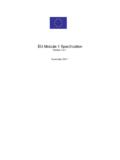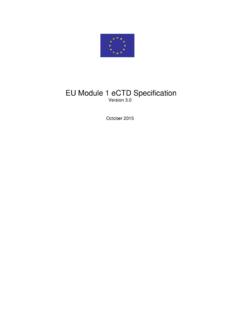Transcription of ICH M2 EWG
1 ICH ectd STF Specification V 3-June-2008 INTERNATIONAL CONFERENCE ON HARMONISATION OF TECHNICAL REQUIREMENTS FOR REGISTRATION OF PHARMACEUTICALS FOR HUMAN USE ich m2 ewg The ectd backbone File Specification for Study Tagging Files This specification has been developed by the ICH M2 Expert Working Group and maintained by the ectd Implementation Working Group in accordance with the ICH Process as pertains to the M2 EWG and ectd change control as it pertains to the ectd IWG. ICH ectd STF Specification V 3-June-2008 The ectd backbone Files Specification for Study Tagging Files Revision History Date Version Summary of Changes 2003-08-13 Original version 2004-03-09 Clarifications to the original version.
2 Constraints from original version including redundancy of information found in the file. Added duration category and values. Added "other" as route of administration value. Added new name attribute values for file tag element. Versions between and have been unpublished drafts 2004-11-17 Provides specification for both Cumulative and Accumulative Approaches for presentation of the Study Tagging Files (STF) with more detailed examples showing index and stf file relationships. Introduces , and 2008-06-03 Removed Cumulative Approach to STF life cycle management and made accumulative approach the only option. Provided clarifications and corrections to text.
3 Page 2 ICH ectd STF Specification V 3-June-2008 THE SPECIFICATION FOR STUDY TAGGING FILES (STF).. 4 I. START AND STOP OF THE 4 II. STUDY-IDENTIFIER 5 A. Title 5 B. study-id 5 C. Category 5 III. STUDY-DOCUMENT AND DOC-CONTENT 7 A. Property 7 B. File-tag 7 IV. LIFECYCLE MANAGEMENT OF THE STUDY TAGGING 10 V. MODIFYING STF 11 A. Changes to the STF Study Identifier 11 B.
4 Changes to STF Study Document 13 VI. STUDY DATA MANAGEMENT 16 A. Distinguishing Time-Specific Analyses Within the Same Subsection of the 16 B. Presenting Information from One Study in a Different Subsection of the 16 VII. EXAMPLE 17 Page 3 ICH ectd STF Specification V 3-June-2008 The Specification for Study Tagging Files (STF) In order to help identify all of the files associated with a study, information is needed on each document including the document title, subject matter (defined by the headings under which the documents are located in the table of contents), relationship to other documents ( , all documents for a specific study report are related to one another), revision information ( , new, replace, delete, append), the location of the document and information on the sequence that included the document.
5 The ectd backbone files ( , and ) include many of those information items. However, the ectd backbone files do not contain enough information on the subject matter of several documents ( , study report documents) to support certain regulatory uses. This additional information is provided in the STF. An STF should be provided with the submission of any file, or group of files belonging to a study in Modules 4 and 5. STFs are required by the United States, are not required in Europe and are not allowed in Japan. The STF provides for additional heading elements and heading attributes not currently provided by the ectd DTD. In the STF, heading elements are called file-tags and are included in the doc-content element.
6 Heading attributes are included in the study-identifier element. Refer to regional guidance for information on STF applicability. I. START AND STOP OF THE STF The STF is an XML instance controlled by the ICH STF Document Type Definition (DTD). The most recent DTD can be found on the ICH web site ( ). The DTD should be placed in the dtd subfolder of the util folder. The stylesheet should be in the style subfolder of the util folder. You should provide a separate STF for each study in a sequence. The name for the STF XML file should start with the term "stf-" followed by the alphanumeric code used by the sponsor to unambiguously identify the study ( , study-id described below) and followed by ".
7 Xml" to complete the file name. For every submission to FDA that includes one or more files pertaining to a specific study, you should provide an STF. You should place the STF for the specific study in the module folder with the corresponding study files. You should place a leaf element for the STF in the appropriate Module 4 or 5 ectd Table of Contents element in the file for that sequence. The operation attribute for this leaf should have a value of "new" for the first STF for that specific study in that ectd element and "append" for any subsequent STF for that same study in that ectd element (see "Lifecycle Management of the Study Tagging File").
8 Subsequent STF files should only include information on the study documents being provided or modified by the subsequent sequence. The subsequent STF should always have a modified-file attribute that refers to the most recently submitted STF provided for that study in that ectd element ( , you should not continually append to the original STF). The version attribute for leaf elements referencing a STF should cite the version of the STF DTD used to prepare that STF ( , Page 4 ICH ectd STF Specification V 3-June-2008 STF version ) to allow the development of tools that can either ignore or highlight the presence of STF XML files.
9 The STF root element is ectd :study. The STF root element contains two child elements. The prolog part of the STF XML document and the STF root element contain information about the following: 1. Version of XML being used 2. Type of characters that are allowed in the file 3. Location of the standards that control the organization of the STF 4. Indication that the file information is ended (end tag) A sample of the root element and last line of the STF is provided below: <?xml version=" " encoding="UTF-8"?> <?xml-stylesheet type="text/xsl" href="../../../../util/ "?> <!DOCTYPE ectd :study SYSTEM "../../../../util/ "> < ectd :study xmlns: ectd =" " xml:lang="en" dtd-version=" " xmlns:xlink=" "> <!
10 --All the elements will be provided after these elements and before the last element closing tag named </ ectd :study> --> </ ectd :study> Note: "../../../../" in the path expressions for STF DTD and STF stylesheet depend on the location where the STF instance is stored. II. STUDY-IDENTIFIER ELEMENT Information describing the study is contained in the study-identifier element of the STF. There are three elements contained in the study-identifier element: title, study-id, and category. A. Title Element The title element provides the full title of the study, not the title of each individual document. B. study-id Element The study-id is the internal alphanumeric code used by the sponsor to unambiguously identify this study.




